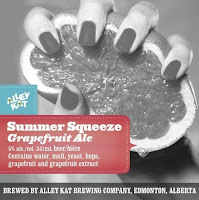 You may have come across an orange-tinged beer in the liquor
store, with a meagre 2.5% alcohol by volume (ABV). This, my friends, is a Radler.
You may have come across an orange-tinged beer in the liquor
store, with a meagre 2.5% alcohol by volume (ABV). This, my friends, is a Radler.
A what?
"Radler" literally translated means
"cyclist" in German, which may have something to do with the low
alcohol content. It has become known as a cocktail consisting of a 1:1 or 3:2
mixture of beer and soda pop. There are
several pre-mixed Radlers that have recently become popular in North America as
well. These include the Schöfferhofer and the Stiegl
Radler.
 |
| F.X. Kugler |
The invention of the drink is widely attributed to the
Bavarian gastronomer Franz Xaver Kugler. Legend has it that Kugler, a
railroad-turned-innkeeper, arranged for the construction of a bike trail
through the forest from Munich to his pub, the Kugleralm. The barkeep soon found himself a victim of
his own success on a
While the legend is somewhat plausible, there are references
to the Radler cocktail that are dated several years before 1922.
There are as many regional differences between Radlers as
there are German dialects. In some
cases, the Radler is distinguished as using a lemon-lime flavored soft drink,
while an Alsterwasser is mixed with an orange flavored soda.
In some areas of Münsterland, they mix beer with an orange
soft drink to make a concoction they call Wurstwasser, or "sausage
water" to describe the color of the drink.
Yummy.
Let's talk about the noble grapefruit for a moment. There are several chemicals in grapefruit
responsible for the bitter taste. The
essential oil of grapefruit is dominated by two compounds - limonene and
myrcene.
 |
| Myrcene IUPAC name, 7-Methyl-3-methylene-1,6-octadiene |
There are many grapefruit flavors present in certain
hops. Cascade hops in particular are
notorious for providing the grapefruit flavor and aroma to beer. The essential oil extracted from Cascade hops
is predominately myrcene (48.9%), while other abundant components include
α-humulene, (E)-caryophyllene, (E)-β-farnesene. So although the two species are
very different, they contain similar compounds that cause grapefruit and
Cascade hops to resemble each other in flavor.
Enter Alley Kat's Summer Squeeze Grapefruit Ale. This is an actual ale brewed with real
grapefruit, and is a tad less sweet than a Radler. While the citrus bite is similar to that of
the German beer cocktail, this is an actual beer with 5% ABV. This seasonal
beer is brewed with real grapefruit, the natural flavor enhances the Cascade
hops without masking the refreshing bitter finish. Get some before it goes back into Alley Kat's
seasonal beer vault when the summer comes to an end.
So I've made beer-sicles before, yes (see Fruits of YourLabour, June 2012). This is entirely
different, I swear. Well, sort of.
 |
| En garde! |
Radler-sicles
Equipment: One
6-well popsicle mould
Ingredients: 2
bottles Radler (Stiegl or other)
- Pour beer into of the popsicle mould until each well is filled halfway. Make sure to pour down the side of the mould to minimize the level of foam.
- Continue to pour, filling moulds within ¼” of the top.
- Insert popsicle sticks and transfer to freezer.
- Share with friends who are over the legal age of majority.
Ort, David. First Draught: Stiegl Grapefruit Radler, a beer
cocktail that’s actually good. http://www.postcity.com/Eat-Shop-Do/Eat/June-2013/First-Draught-Stiegl-Grapefruit-Radler-a-beer-cocktail-thats-actually-good/
German Beer Institute
http://www.germanbeerinstitute.com/Radler.html
Hops. The Hopry. http://thehopry.com/hops/
Nance M.R. and Setzer W.N. Volatile components of aroma hops
(Humulus lupulus L.) commonly used in beer brewing. Journal of Brewing and
Distilling Vol. 2(2) pp. 16-22, April 2011.

No comments:
Post a Comment